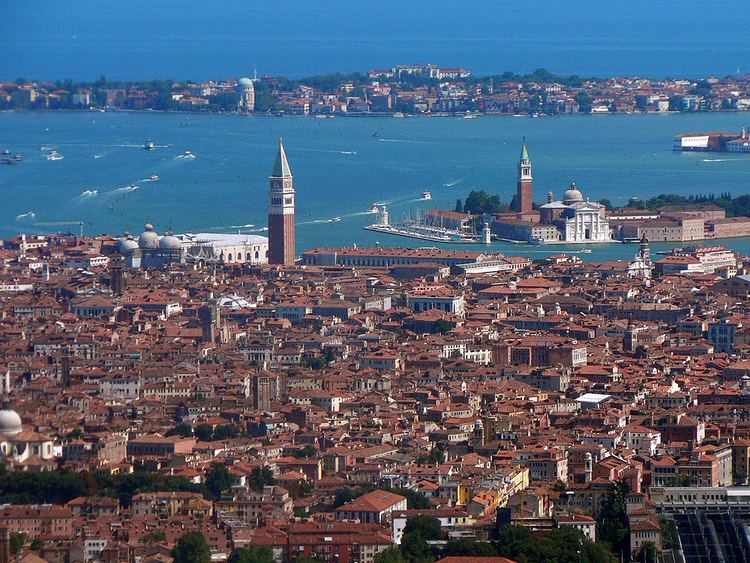Time zone CET (UTC+1) | Comuni 44 | |
 | ||
Postal code 30010, 30014-30016, 30020-30039 | ||
The Province of Venice (Provincia di Venezia) was a province in the Veneto region of northern Italy. Its capital is the city of Venice. It had an area of 2,467 km², and a total population of 846,962 (2011). The province became the Metropolitan City of Venice in 2015.
Contents
Map of Venice, Italy
History
The area was settled by 11th century BC. According to legend, Antenor fled from Troy, leading the people of Eneti from Paphlagonia to inhabit the shores of the Adriatic. In 102 B.C., The Romans defeated the Cimbri and the Germanic tribes in the area, thus increasing their influence in the region to form the Regio X Venetia et Histria. The exact date when Venice was established in unknown, but about 570 refugees from the hinterland, especially from Aquileia, fled to the islands of the Venetian Lagoon in order to escape the frequent barbaric invasions. At that time, the territory of the province was part of the Byzantine Empire, belonging to the Exarchate of Ravenna. Over the centuries, Venice became more independent and in 697 it had its first Doge. With the destruction of Eracliana in 805, the capital was moved to Rialto (Venice).
In the Middle Ages, Venice became an important maritime republic, completely independent from Byzantium, and began its expansion into the hinterland. In 1260, the Ezzelini family were defeated. Threatened by the expansionist ambitions of the Visconti of Milan, in 1365, Venice began to invade neighbouring territories. By 1410, the Regio X Venetia et Histria had annexed Padua and Verona, and by the 16th century the republic included territories from the Julian Alps to Crema, Istria, Dalmatia, Cyprus and part of the Peloponnese. In 1797, Napoleon invaded the Republic and, following the Treaty of Campo Formio, it was ceded to Austria. After the final defeat of Napoleon, the Austrian Empire founded a province of Venice on the Adriatic.
Geography
Facing east on the Northern Adriatic Sea, the province was bordered to the northeast by the Province of Udine and Province of Pordenone, south by the Province of Rovigo, and to the west by the Province of Padua and Province of Treviso. The municipalities of Chioggia, Cavan and Cona constituted an exclave separated from the rest of the province, bordering the provinces of Padua and Rovigo.
The Brenta and Livenza rivers flows through the former province. The Piave River flows into the Adriatic after passing the town of Eraclea. The 174 kilometres (108 mi) long Brenta runs from Trentino to the Adriatic Sea just south of the Venetian lagoon. It was first channeled in the 16th century when a long canal was built from the village of Stra to the Adriatic Sea, bypassing Venetian lagoon. A branch of the Brenta, named Naviglio Brenta, was left to connect directly Venice and Padua. The river runs through Stra, Fiesso d'Artico, Dolo, Mira, Oriago and Malcontenta to Fusina in the north-east.
In areas that bordered the Friuli Venezia Giulia Region, it is estimated that 29% of the population speaks fluent Friuli. The language is officially recognized and has been protected as a minority language since 2006.
Demography
Statistics recorded since 1871 show that the population of the Province of Venice increased from some 341,000 inhabitants in 1871 to almost 847,000 in 2011. It rose steadily in each of the ten-year statistical periods until 1981 (reaching 838,794 inhabitants) whereafter there were declines until 2001 when the population dipped to 809,586. Finally, there was an increase of 4.6% in the ten-year period from 2001 to 2011 when the number of inhabitants reached 340,913.
The average age per inhabitant was 44.8 years in 2011, up from 35.6 years in 1981. In 2012, there were 72,284 foreigners residents in the province (up from 44,996 in 2006), mainly from Romania, Moldova and Albania, representing 8.5% of the total population. In the academic year 2012 to 2013, 23,677 students were enrolled at university of which 61.8% were women and 38.2% male. The most popular fields of study were economics, foreign languages, letters and philosophy, and architecture.
Comunes
There were 44 comuni (singular: comune) in the province [1]. In 2005, the main comuni by population were:
Economy
Tourism was an important contributor to the provincial economy with over 26,000 establishments (including 1,277 hotels) offering overnight accommodation and accounting for a total of 34 million tourist nights spent in 2012 (down slightly from 2011 but substantially higher than some 29 million nights in 2002).
The Gross Domestic Product of the province was 25 million euro in 2010, down slightly from 25,973 in 2007. In 2012, the service sector represented 73% of the economy, while industry covered 19%, construction 7% and agriculture just 1%. Footwear represented 9.6% of provincial exports, petroleum products 7.2% and machinery 6.7%.
